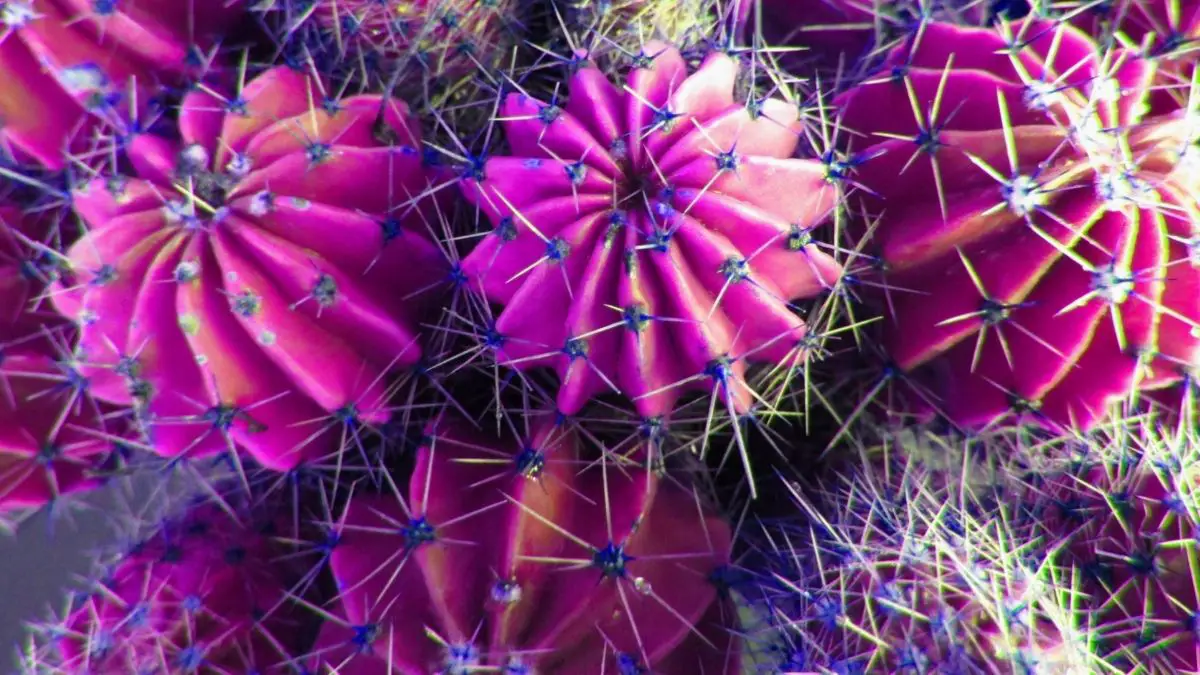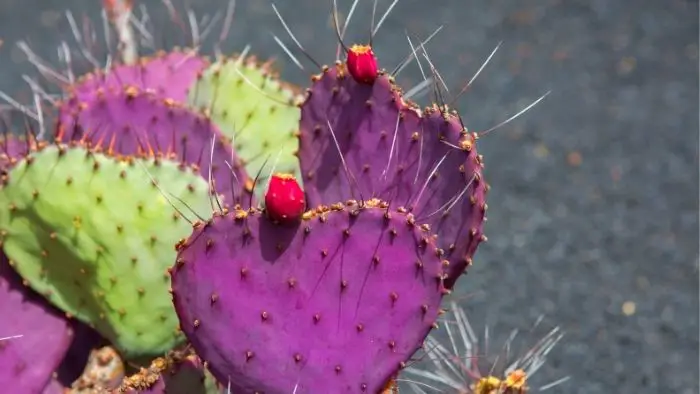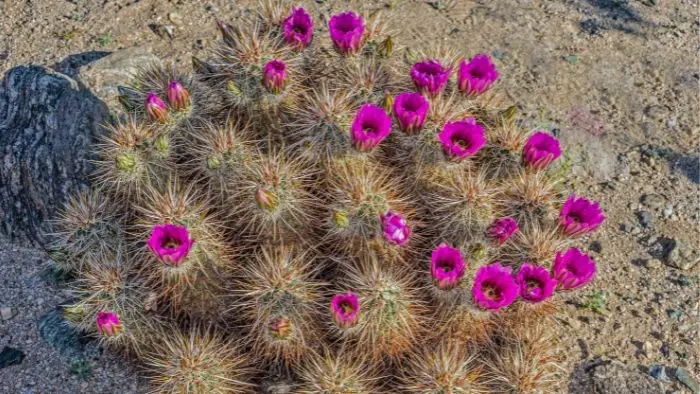Last Updated on August 11, 2022 by Cinthia
Cacti turn purple as a sign of stress generally. When we ask “Why is my cactus turning purple?” we know it is due to stress most likely. Stress is quite a broad category, hence in this article, we take a look at the types of stresses a cactus can be exposed to, and how we can mitigate these stresses. Luckily, cacti do not suffer emotional stress, so it is easier to deal with them than people.
What Is The Purple Color In A Cactus Or Succulent?
Plants produce many different pigments for different purposes. In cacti and succulents, a common sign of stress is the production of anthocyanin, betacyanin, and related pigments. These are pigments that confer a pinky red color to plants. This purple color helps the plant protect itself under stressful conditions.
In many cases, anthocyanins are produced in succulents to perform a photoprotective role – succulents are often water-stressed, hence under conditions of low water, even though they can employ water-efficient CAM photosynthesis, they will need to further reduce the amount of light reaching the chloroplasts – anthocyanin pigments can do this. The result is that a plant that is under water and light stress conditions will often go a purple color. This can be desirable, as some plants just look great when they get nice colors – but it can also be a sign that if you go too far, you may lose your succulent or cactus.
Ok, we understand a bit about the biochemistry of the purple color now, but why is my cactus turning purple? What are the actual reasons?
Why Is My Cactus Turning Purple?
When asking ourselves why is my cactus turning purple we first need to ascertain what type of cactus we have. There are many cactus types that are actually naturally purple.
Naturally Purple Cacti
Some cacti types naturally have a purple color. Good examples are:
Opuntia Macrocentra
This plant, native to the drier regions of the Southern US, is also known as the Purple Prickly pear. It has naturally pink to purple pads, and it is just a plant of great beauty. The fruit is dark red and edible. The pigments in the fruit are powerful antioxidants. I find they make pleasant mead as well when mixed with honey, strained to remove seeds, and fermented.
Echinocereus Engelmannii
The Strawberry hedgehog cactus is another cactus that is able to adapt to very hot dry areas, and it can take on a natural purple color as part of its protective strategy to live in these conditions.
Learn more about: The Best Fertilizer for Cactus and Succulents
Cacti That Turn Purple Under Light Stress
Many cacti and succulents will turn purple under light stress. If you have a cactus or succulent and it is starting to turn purple, the first question to ask, is how much light does my plant get, how intense is the light, and for how long does it get light?
Cacti generally employ CAM photosynthesis. This system allows Cacti to thrive under conditions of relatively low water and high light. Sometimes they will have to protect their photosynthetic pigments if light intensity gets too high, and this can lead to purpling of the leaves.
If your cactus is in a very sunny spot, try and see if you can move it back a little and see if this improves the appearance of your plant.
Ideal Temperatures To Avoid Having Your Cactus Turn Purple
Many cacti and succulents are adapted to desert environments where the days are quite warm and the nights quite cold. This helps them with their metabolism. Here is a graph of the Phoenix Arizona average day and night temperatures. You will see there is a significant fluctuation in day-night temperatures. If you place a max/min thermometer in a spot near your cactus plant you can get an indication of the temperatures it is being exposed to.
Minimum Temperature
You may find that it is being exposed to temperatures that are too high during the day and too low at night – windows often get really cold at night and a layer of cold air runs down the windows onto plants on the windowsill. If you are in an area with a colder climate, this cold air can be below the temperature that cacti are comfortable with. I generally find that most Cacti thrive if temperatures do not regularly drop below about 45 °F.
My friend loves to grow Lophophora williamsii cacti for various reasons. Typically his plants are dark green and thrive in his greenhouse. Recently a tree nearby fell down, and the greenhouse now gets a lot more light, and consequently gets warmer. The plants began to turn purple as is evident above. Providing the plants with a little bit of shade netting caused the purple color to abate and the plants are back to peak health now.
Maximum Temperature
They also do not really enjoy temperatures that go above 90°F. Some cacti are adapted to be able to tolerate higher temperatures. An important thing to remember is that you may find that you are reading an air temperature of 90°F but the leaf/pad/steam temperature may be way above this if the plant is in direct sunlight. I once borrowed my friend’s infrared thermometer gun, which was similar to this one. What I found was that in areas where there was a breeze, leaf temperatures and the air temperature were not too far apart – in my greenhouse, however, leaves that were in direct sunlight had temperatures at least 10°F higher than the ambient temperature!!
My Cactus Is Turning Purple Because It Is Very Wet
Something about that sentence sounds like it could be terribly misinterpreted. In this regard, we are referring to a succulent plant that has turned purple because the soil in its pot is too wet. When it comes to the topic “Why is my cactus turning purple”. When cacti and succulents are exposed to excess water – when I say this I mean a soil that is soggy wet – you can press it and water will squeeze out – their roots can drown. This is pretty much a given for almost all plants, but cacti are really particularly badly adapted to wet environments and they just give up if they are exposed to too much water.
I would recommend getting a soil meter such as this one. This meter will allow you to measure the soil moisture and temperature as well as light intensity. For cacti, it is pretty important to let your soil go from moist to dry over a period of two to three weeks. This wet and dry cycle is something that cacti and succulents enjoy.
My Cactus Is Turning Purple Because It Is Very Dry
The majority of cactus plant killers kill them by overwatering. There are however those extra special folks out there who can actually kill a cactus by underwatering it! I am one of those idiots! I literally once killed a beautiful cactus by underwatering it. At least I thought I did! It had shriveled up and was just a spiky ball of thorns with a little purple nut of plant matter in the middle. I took the whole thing and just threw it away – two years later, I found the cactus alive and thriving in the spot where it landed!!
If the soil in your cactus pot is so dry that it is like dust – and you cannot remember when you last watered the cactus – and the cactus is a weird purple color, give it a little water. Remember, this is much like reviving a person who has nearly died of dehydration – if you give them too much water you will kill them! Rather just start with a small drizzle of water, and do that every two to three days, and watch the cactus slowly reinflate and eventually lose its purple hue. They actually seem to enjoy being partially dried out every now and then. It gives them that real desert experience. Often they flower like crazy after one of these near-death experiences.
Nutrient Issues
Cacti are generally not very heavy feeders – but over time they can deplete the soil. When it comes to our question of “Why is my cactus turning purple?” a very common cause is a phosphate issue. You can use a simple fertilizer preparation such as this which is specially formulated for cacti and succulents.
I have to admit, and it may get me in a little trouble as I am not sure about the rules of etiquette in sharing such secrets on public media, but, if your cacti are looking a bit sad and run down, a little bit of human pee can make a big difference to them. Once or twice a year, and this is my secret to keeping my cacti healthy. It is abundantly available, cheap, and free. I have, in due course, learned that the over-application of said soil amendment can cause your cacti and succulents to turn purple, so be careful. The application of small doses will also not come with any odor problems which can cause strife in the house if such issues appear.
I hope this has helped you answer our question “Why is my cactus turning purple?” Cacti are special plants, and learning how to give them just the right amount of attention and neglect for them to thrive is quite a challenge. With the above guidelines, you can figure the whole thing out. If you enjoyed this please share.
FAQs
What are the signs of a dying cactus?
If it looks a bit soggy, and has rotting spots on it you are probably witnessing a cactus dying. They tend to hate being overwatered and this is the easiest way to kill them. On very rare occasions, underwatering a cactus can cause it to give up as well. If the soil is dry, and it looks half dead, then probably that is why. Give it a little water. If the soil is very wet, and it looks half dead - remove if from the soil, let its roots dry out for a day or two, and put it in some decent well drained soil. Do not overwater it again. Buy a water meter, and give it just enough water to be "moist" and then allow it to dry out and water again in two to three weeks. These things survive in deserts that get a few inches of rain every few years - do not spoil your cacti with too much water. They just hate it.
Why is my cactus changing color?
It can be for a number of reasons. The most common is over or under watering, or too much or too little sun. It is just impossible to answer this question in this amount of space, so I am sorry - read the article.
What does an overwatered cactus look like?
This will depend on the cactus but if the soil is very wet, and has been for a long time, they tend to go all sorts of creative colors - dark purple, red, yellow and they often get little rotting patches and just look all round miserable. If a cactus is looking a bit weird, and the soil is very wet, chances are it is an overwatered cactus. Remove it from the wet soil, repot in dry soil and let it heal for a while before you water it. These things can take abuse - as long as it is not water abuse.
How do you revive a dehydrated cactus?
There is an urge that we have to just pour lots of water on it - this can actually shock the poor thing. Rather just give it a little water, and then follow up every few days until it starts to swell up and recover. Cacti when they get really stressed can actually rupture if you give them too much water. So start slow, and nurse your little spiny friend back to life.
Dr. Garth A. Cambray is a Canadian/South African entrepreneur and beekeeper with 28 years of experience in apiculture and specializes in adding value to honey. His Ph.D. research developed a new advanced continuous fermentation method for making mead that has resulted in a number of companies globally being able to access markets for mead. His company, Makana Meadery, exports honey mead to the USA where it is available to discerning connoisseurs. He has also developed technologies to commercially manufacture organic honey vinegar in Zambia for export globally. He holds a few patents globally in the ethanol industry and believes in technology and knowledge transfer for human development and environmental sustainability. One of his proudest achievements is the fact that the wind farm he started at one of his old apiary sites has essentially made his hometown carbon neutral.








